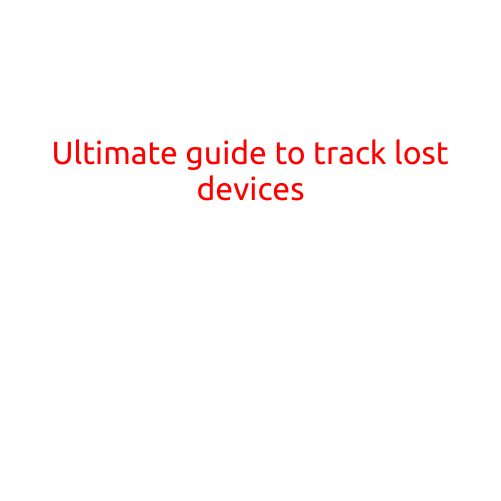
Ultimate Guide to Track Lost Devices
Losing a device can be a stressful and frustrating experience. With our increasing reliance on technology, it’s not uncommon for us to misplace or lose our phones, laptops, tablets, or other devices. But fear not! With the right tools and techniques, you can track and recover your lost devices with ease.
In this ultimate guide, we’ll cover the best ways to track lost devices, including GPS tracking apps, remote tracking services, and alternative methods to help you recover your lost devices.
GPS Tracking Apps
GPS tracking apps are designed to help you locate your device on a map using the device’s GPS capabilities. Here are some of the best GPS tracking apps:
- Find My iPhone (FMI): Apple’s Find My iPhone app is a popular choice for tracking lost iPhones. FMI uses GPS, Wi-Fi, and cellular data to locate your device and provide you with a map display to help you track it down.
- Find My Device (FMD): Google’s Find My Device app is a GPS tracking app designed for Android devices. FMD uses GPS, Wi-Fi, and cellular data to locate your device and provide you with a map display to help you track it down.
- Lookout: Lookout is a GPS tracking app that works with both Android and iOS devices. Lookout uses GPS, Wi-Fi, and cellular data to locate your device and provides you with a map display to help you track it down.
Remote Tracking Services
Remote tracking services are designed to help you locate your device from a remote location. Here are some of the best remote tracking services:
- Lookout Premium: Lookout’s premium plan offers remote tracking capabilities, allowing you to track your device’s location from a remote location.
- GPS Phone Tracker: GPS Phone Tracker is a remote tracking service that allows you to track your device’s location from a remote location.
- TrackR: TrackR is a popular remote tracking service that allows you to track your devices, including phones, keys, and more.
Alternative Methods
In addition to GPS tracking apps and remote tracking services, there are several alternative methods you can use to track lost devices:
- IMSI Catcher: An IMSI catcher is a device that can be used to track lost devices. It works by capturing the IMSI (International Mobile Subscriber Identity) number of your device, which can then be used to track it down.
- Signal Strength: If you have a device that uses cellular technology, you can try using the signal strength to track it down. By tracking the signal strength of your device, you can determine its location.
- Wi-Fi Networks: If your device is connected to a Wi-Fi network, you can try using the network information to track it down. Many devices will broadcast their Wi-Fi network information, which can be used to track it down.
Best Practices
To increase your chances of recovering your lost device, follow these best practices:
- Back up your data: Regularly backing up your data can help ensure that your personal information and data are not lost or compromised.
- Use a strong password: Using a strong password can help prevent unauthorized access to your device.
- Use a tracking app: Using a GPS tracking app can help you locate your device if it’s lost or stolen.
- Keep your device up to date: Keeping your device up to date with the latest software and security updates can help prevent it from being compromised.
- Use a device locking service: Using a device locking service can help prevent unauthorized access to your device.
Conclusion
Losing a device can be a stressful and frustrating experience, but with the right tools and techniques, you can track and recover your lost devices with ease. By using GPS tracking apps, remote tracking services, and alternative methods, you can increase your chances of recovering your lost device. Remember to follow best practices, such as backing up your data, using a strong password, and keeping your device up to date, to help prevent data loss and unauthorized access.





